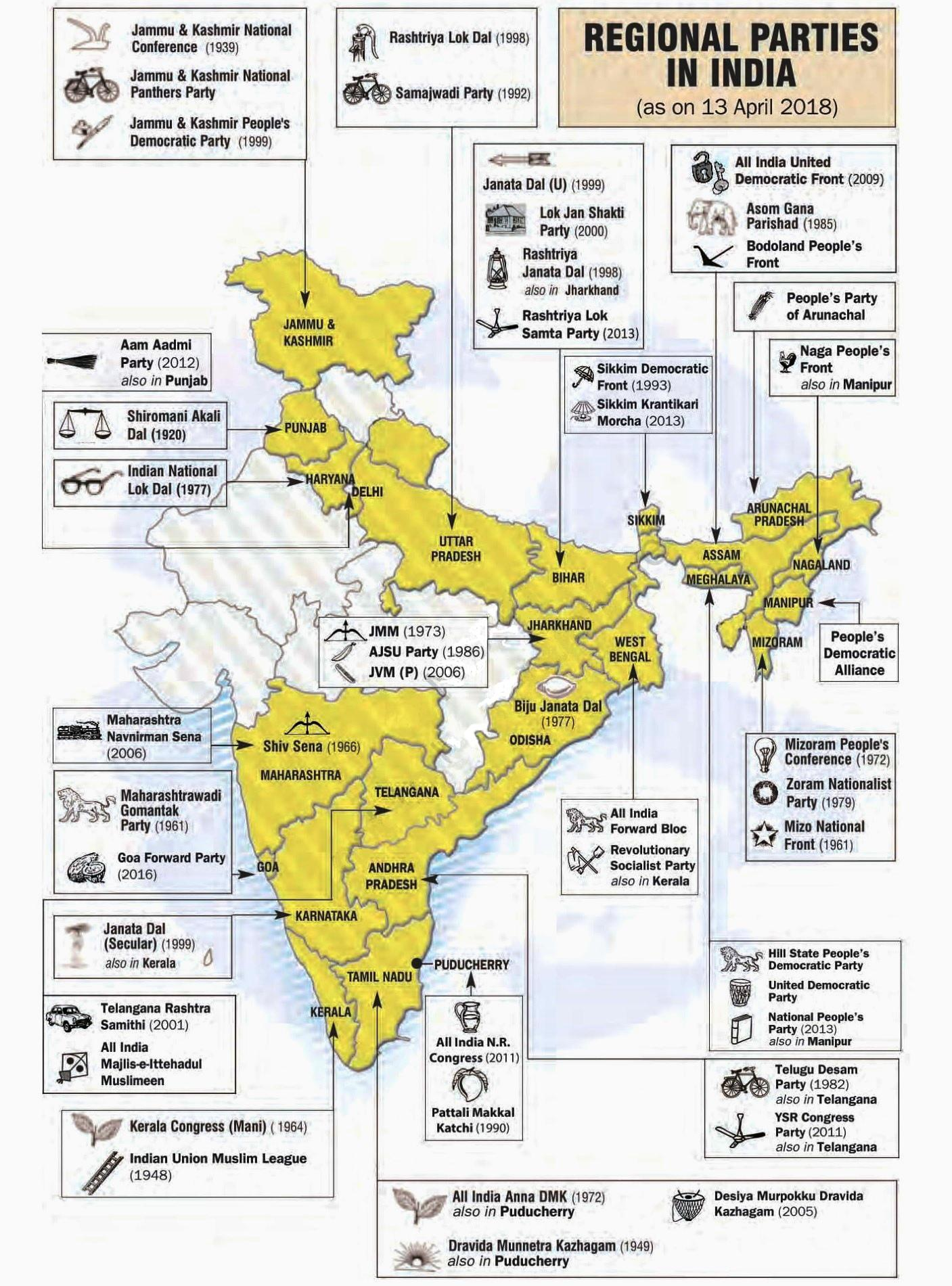Civics Class 10 Political Parties Notes Chapter 4 - Download FREE PDF
Political Parties Class 10 Notes: CBSE Civics Chapter 4

FAQs on Political Parties Class 10 Notes: CBSE Civics Chapter 4
1. How can the Political Parties be Reformed?
One of the significant highlights of the Political Parties Chapter 7 is the reform of the political parties. The political parties can be reformed in the following ways:
Elected MLAs and MPs are prohibited from changing parties according to the amendment of the Constitution.
The Supreme Court of India passed a verdict to trim down the involvement of money and muscle power in the elections.
A significant law was passed by the Election Commission of India by making it mandatory for the political parties to conduct their organizational elections and submit their income tax returns.
Apart from that, the following steps can be implemented to reform the political structure of India:
The internal affairs of the political parties should be reviewed on a regular basis.
Women candidates should be given preference.
State funding for elections is also a very important aspect which must be adopted.
2. What are the State Parties of India?
Class 10 Chapter 4 Political Parties shows how there is a perfect blending of various significant ideas as far as the political scenario of India is concerned. Some of the major parties in India are classified as the ‘State Parties’ by the Election Commission of India. These parties include:
Biju Janata Dal.
Mizo National Front.
Telangana Rashtra Samithi.
Sikkim Democratic Front.
Apart from that, there are also several regional parties in India which play very prominent roles in the shaping of Indian politics.
3. What are various challenges faced by political parties?
There are various challenges faced by political parties:
They Experience Conflicts within Themselves: It happens because it might be possible that one or two parties hold more power than others, so it creates conflict in themselves.
The Succession Rule: This is the problem with most of the parties as they choose one head and then their successors take charge after that. This restricts other ministers to take a chance to hold a higher position.
4. Suggest some reforms to strengthen parties so that they perform their function well.
Various reforms can be followed by the political parties to strengthen them so that they perform their function well:
Can Increase Women's Representation: If parties want to strengthen themselves, they should increase the participation of women in their parties, as we already know that the majority of the ministers are men. Hence, by giving a chance to female candidates, these parties can stand out differently.
Not to Promote People with Criminal Records: If the party will not accept people with criminal records as their members, they can create a strong image.
5. State various functions political parties perform in a democracy.
The functions which are performed by political parties are:
They introduce people with various policies which they promise to fulfill if they win the elections.
They give their strong points in law formation as when they are in power they make laws and when they are in opposition then they argue on the topics which they feel are not good in the proposed bill.
People get influenced by their ideologies. They play with people’s opinions and alter them as per their needs.
6. Is Class 10 Civics Chapter 4 Notes difficult?
Nothing is tough if your fundamentals and concepts are crystal clear. With good concentration power, nothing seems to be that difficult. This chapter mainly talks about political parties, their functions, the power they hold, opposition, etc. In this chapter, you will find the things which political parties need to improve in themselves and how they can stand out differently by following some reforms in their contemporary working style like how with women’s participation their political party can improve its image.
7. Are Political Science Class 10, Chapter 4 Revision Notes useful?
Yes, the Class 10 Political Science Chapter 4 revision notes are useful for students. These are the most important notes that must not be left by a student who is preparing for the Class 10 board examination. You can revise and crack this chapter thoroughly, by referring to the Class 10 Political Science Chapter 4 revision notes provided by Vedantu. These notes are reliable and accurate and come in handy for last-minute revision before the Class 10 Political Science exam and are available to download FREE PDF.
8. How do revision notes help in understanding political parties?
Revision notes summarise the key roles and functions of political parties, making complex information easier to understand. They highlight essential details, helping you quickly recall important concepts.
9. What should I focus on in Political Parties Class 10 short notes?
Focus on the main functions of political parties, major national parties, their symbols, and leaders. Also, include their impact on the political system and recent election results in Political Parties Class 10 short notes.
10. How can I use Class 10 Civics Ch 4 notes to prepare for exam questions on political parties?
Use the notes to review and summarise important concepts. Practice answering sample questions based on the notes to test your understanding and preparation.
11. Why are Political Parties Class 10 short notes important?
They simplify complex information about political parties and provide a structured overview. This makes studying more efficient and helps ensure you remember key points for exams.
12. How often should I review my Class 10 Civics Ch 4 Notes?
Regularly review your Class 10 Civics Ch 4 notes to reinforce understanding and retention. Frequent revision helps ensure you are well-prepared and confident before the exam.




















 Watch Video
Watch Video















